 Suffixes
Suffixes
On the Vowels page, I told you about semivowels, vowels being used as consonants. To write them, we just added a vertical line to the corresponding vowels. On this page, we're going to talk about another use for some of those letters, as suffixes. A Musa suffix is a letter with a slender top which is written after another letter to modify its value. It's similar to how the letter h is used in English to modify the values of other letters in digraphs like ch sh th. By coincidence, lowercase h is also a slender letter :)
Some suffixes are used to write secondary articulations. A secondary articulation is a sound that's made at the same time as another sound. The second sound "colors" the first without dominating it.
Palatalization, Velarization, and Labialization
A consonant is palatalized when, while the consonant is being articulated elsewhere, the body of the tongue is also raised to form a secondary articulation against the palate, as if you were saying y at the same time as you said another sound. In Irish, these consonants are called slender, in English they're called light, but in the Slavic languages, they're called soft, and that's what I'll call them.
The opposite of palatalization is called velarization. Sometimes, the tongue really is pulled back against the velum, but often, velarized consonants are just retroflex, or pronounced with the largest possible opening under the palate; in other words, exaggerating the contrast with palatalization. These consonants are called broad, dark or hard - I'll use the last term.
We also sometimes round our lips as we pronounce a consonant; this is called labialization. There are actually two ways to round your lips: the first is protruded, as if you were kissing someone, for example when we pronounce u or w in English. That's called exolabial rounding. The second is compressed, where your lips come together to make your mouth opening very small, but they don't protrude. That's called endolabial rounding. Usually, back rounded vowels are exolabial, and front rounded vowels are endolabial.
All of these articulations often occur under the influence of adjacent vowels. Front vowels (and their lax counterparts) tend to soften adjacent consonants, while back vowels tend to harden them, and rounded vowels tend to round them. These influences are so normal that we don't write them - they're taken for granted.
But some languages use an unexpected secondary articulation to create a contrast. For example, they might soften a consonant before a back vowel, or harden it before a front vowel. If the secondary articulation is so strong that it moves the primary articulation, then we just write the adjusted letter. For example, Chinese velar consonants g k h become palatal j q x before front medials, and we just write them with palatal letters, not with suffixes. But in many cases, the difference isn't that extreme, so we use suffixes, but only in the unexpected cases.
In Musa, we indicate that a consonant is unexpectedly soft using as as suffix. We write unexpectedly hard consonants using as a suffix. We write unexpectedly round hard consonants using as a suffix for exolabial rounding, and as a suffix for endolabial rounding. And when a soft consonant is unexpectedly round, we write as a suffix.
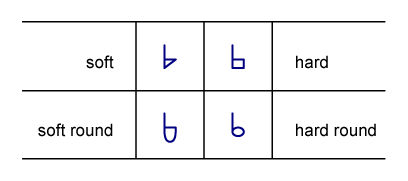
Labialization - lip rounding - is very common around the world, and it's usually accompanied by velarization. We usually use w to spell that, but when there's labialization without velarization, we spell it with yw .
We don't usually need to use these signs if the following vowel plays the same role. For example, we can omit the soft sign before a front spread vowel, since it's normal that front vowels palatalize the preceding consonant, at least a little. Likewise, we don't need to write the hard sign before a back spread vowel, since those consonants are already velarized. And we can omit the two rounding signs if the vowel is already rounded, unless we need it to indicate hardness or softness.
To show you how these suffixes work, let's look at a complicated case. Russian has only five vowels, but the Cyrillic alphabet uses ten vowel letters to write Russian: five (а э ы о у) that indicate that the preceding consonant is hard, and five (я е и ё ю) that indicate that it's soft. There are also special signs - a hard sign ъ and a soft sign ь - for use when there's no following vowel. But the soft front vowels are much more common than the hard ones, while the hard back vowels are much more common than the soft ones.
When we write Russian in Musa, we don't use a soft suffix to indicate a soft consonant before the vowels и е - that's assumed. But we assume that other consonants are hard unless they're marked as being soft. Here are some examples:
| пат | | stalemate | пять | | five |
|---|---|---|---|---|---|
| это | | this | есть | | is |
| быть | | to be | бить | | to beat |
| его | | his | её | | her |
| мюзикл | | musical | музыка | | music |
In Russian, soft signs can be omitted after palatal consonants ч щ, and hard signs can be omitted after retroflex ж ш - those consonants are presumed to include the suffix. But in Chinese, we never omit those letters after the same consonants, because in Chinese they represent medial semivowels, not secondary suffixes as in Russian.
Adjacent consonants - a consonant cluster like fl or kr - don't need to use a suffix after every consonant: a single suffix or vowel suffices for the whole cluster. However, there are many exceptions where you will have to write a suffix in the middle of the cluster: soft consonants before hard ones, as in только , and hard consonants before soft ones, as in лапки . Here's a line from the Russian anthem, with soft letters highlighted in yellow:
| Славься, страна! Мы гордимся тобой! |
|---|
| |
If the vowel is round, we use the round versions of the suffixes. The Russian word нёс features the soft round suffix before the ё, which both palatalizes and labializes the н.
| |
| нёс |
|---|
Neither Musa nor Cyrillic distinguishes between iotation (the insertion of a y sound between consonant and vowel) and palatalization: we write both with ь . Cyrillic sometimes adds a soft sign before a soft vowel to indicate when it needs both the suffix and the semivowel. In such cases, Musa uses its special letter for approximant y :
| |
| дьявол |
|---|
| devil |
The hard suffix is less common, but it should be used when a hard consonant precedes a soft letter. For example:
| съехать | | to move out |
|---|---|---|
| объединить | | to combine |
The w semivowel is used as a suffix to indicate a consonant that is labialized - pronounced with the lips rounded. For example, most dialects of English round the lips when pronouncing the r sound (before a vowel): red is actually pronounced rʷed [ɹ̠ʷɛd].
Labialization of velar consonants is so common in numerous languages that Musa has special letters for it, the rounded velar letters you met on the More Positions page.
The round suffix is also used for the back flat sounds of Berber, and for the whistled sibilants of Shona.
Prenasal Prefix
The letters you met above are all suffixes - they go after the consonant they modify. Musa has one prefix: a letter you write before the consonant it modifies.

We use the prenasal prefix to write prenasalized consonants, which are obstruents with a nasal onset. They occur in many languages, in some of which they even contrast with the cluster of nasal + obstruent, as in the English pronunciations of combo condo congo. But prenasals function as a single consonant - in fact, many of the languages in which they occur have no consonant clusters - and the nasal segment is usually shorter than in the cluster. But they are most often used when not following a vowel.

Here's the name N'Djamena, the capital of Chad:
| |
| N'Djamena |
|---|
This prefix is also used as a suffix to indicate a nasalized consonant, a consonant with nasal release. More often, the nasal is written as a full consonant, forming a cluster, especially when followed by a vowel.
Emphatic Suffix

Arabic features emphatic consonants: uvular or pharyngeal versions of d t s dh (or z) ' h and k, the normal r, plus a special emphatic l as in the word Aḷḷah. Generally, they are phonetically uvularized or pharyngealized, which means they have a secondary uvular or pharyngeal articulation. More important, these consonants have an effect on neighboring sounds. Musa represents them with the Emphatic suffix. In other languages where cognate consonants are glottalized or expressed in some other way, they're written differently: if they're ejective or implosive, we spell them with those letters, and if they are velarized or labialized, we use the appropriate suffix.
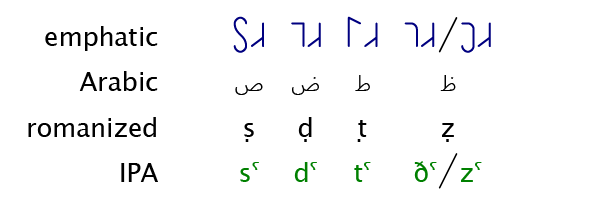
These letters are also used for the front flat sounds of Berber, and for other sounds involving the back of the throat. For example, isiZulu is the most spoken first language in South Africa, with about 10 million speakers. It features ejective, aspirated, and implosive stops (which are now written with normal voiced letters). But it also features "depressor" versions of the voiced stops, which make the following vowel breathy and change its tone. Musa writes these depressor consonants with an emphatic suffix. As with emphatic consonants in Arabic, the use of a suffix here facilitates the regrouping of the suffix with the vowel as a voice- and tone-changing onglide.
Lateral Suffix

The lateral suffix is used to spell sounds with a lateral release (although Musa has letters for the coronal ones).
Glottalization

A sound is glottalized when your glottis is closed (or partly closed) during the pronunciation of another sound. Many British dialects of English feature glottalization of final or intervocalic t, when the t is either reinforced or even replaced with a glottal stop.
Modifier Suffixes
Six other suffixes are used to modify the normal sound of the letter they follow, instead of adding a secondary gesture. They come in pairs, each pair modifying one attribute.
-
To indicate a sound that is advanced relative to a Musa letter, use the suffix. For example, to show that the k of keep is a little more palatal (but not palatal ) than the "normal" k of cup, you could write it .
To indicate a sound that is retracted relative to a Musa letter, use the suffix. For example, to show that the k of coop is a little more palatal (but not uvular ) than the "normal" k of cup, you could write it .
To indicate a sound that is raised (mouth more closed) relative to a Musa letter, use the suffix. For example, to show that the wh of whilst is a little more rough than its normal approximant pronunciation (but not a fricative), you could write it .
To indicate a sound that is lowered (mouth more open) relative to a Musa letter, use the suffix. For example, to show that the d of Spanish cansado is even more relaxed than its normal fricative pronunciation (but not an approximant), you could write it .
To indicate a sound that is more voiced or less breathy than a Musa letter, use the suffix. For example, if you think that the devoiced g in disgust is still not as voiceless as the unvoiced k in discussed, you can write the former as . But the most common interpretation of this "stiff" suffix is to spell creaky voice.
To indicate a sound that is less voiced or more breathy than a Musa letter, use the suffix. For example, Musa doesn't have letters for aspirated fricatives, but if you wanted to write one, you could add this suffix to any unvoiced fricative, for example . But the most common interpretation of this "slack" suffix is to spell breathy voice.
Recap
Here are all the suffixes:
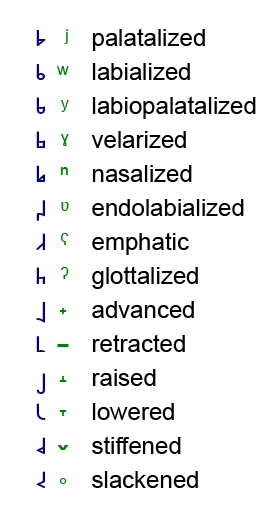
Seven of these suffixes ( ) are also used as semivowels, so there is some ambiguity (as there is with IPA diacritics) between, say, a labialized tʷ and a t with a w offglide, both written . We offer a solution below: write the suffix as a ligature, and the offglide as a separate suffix letter, using ZWNJ as separator. If the offglide is y or w, you could use the special approximant letters and .
Ligatures
Some fonts combine the two letters of a digraph into one taller letter that features three shapes instead of just two. We call these letters ligatures. There are several different types. The most common combines a letter with a following suffix - the vertical top of the suffix is discarded, and the bottom of the suffix is attached to the letter.
For example, as you learned above, almost all Russian consonants come in pairs: one member of each pair is soft (palatalized), and the other is hard. The hard sounds are spelled with normal tall Musa letters, but in ligature fonts, the soft ones are spelled with ligatures whose bottom shape is a Nu triangle - the same shape as the bottom of palatal consonants. Here are the ligatures for Russian soft consonants:
| бь bʲ | дь dʲ | вь vʲ | зь zʲ | гь gʲ |
| пь pʲ | ть tʲ | фь fʲ | сь sʲ | кь kʲ |
| мь mʲ | нь nʲ | ль lʲ | рь rʲ | хь xʲ |
When typing a ligature, you have to separate the bottom of the first letter from the suffix with a Yu - a vertical line - just as if you were typing out the suffix. In the 1D form, the ligature bottom or the suffix is a separate letter. But in the 2D form, the three shapes of a ligature are all squeezed into the same space as a normal letter. In fonts with ascenders and descenders, ligatures are both. Here are the same emphatic letters you met above, this time as ligatures:

When the bottom of the first letter is also Yu (the vertical line), ligatures have an extra fillip to differentiate them from similar letters:

As you can see, it's easier to read a ligature than letter + suffix. Here are some of the most common ligatures:
| Ligature | Suffixed Equivalent | Transcription | Example |
|---|---|---|---|
| | | by | Russian byeliy |
| | | py | Russian Pyotr |
| | | dy | Russian gdye |
| | | ty | Russian tyopliy |
| | | gy | Japanese gyoza |
| | | ky | Japanese Kyoto |
| | | k'y | Hausa k'yalala |
| | | my | Russian medved |
| | | ny | Spanish senior |
| | | vy | Russian Vyacheslav |
| | | fy | Russian Fyodor |
| | | zy | Russian zelyonniy |
| | | sy | Russian sem' |
| | | ry | Japanese Ryukyu |
| | | ly | Italian Italia |
| | | gw | Cantonese Gwongdung |
| | | kw | Cantonese Kwai Tsing |
| | | k'w | Hausa k'wabe |
| | | sw | English swine |
| | | shw | English schwa |
| | | emphatic d | Arabic daad |
| | | emphatic t | Arabic taa' |
| | | emphatic dh | Arabic zaa' |
| | | emphatic z | |
| | | emphatic s | Arabic saad |
A second type of ligature combines the prenasal prefix with a following letter, omitting the vertical line top of the prefix. Here are the same prenasals you met earlier, this time as ligatures:
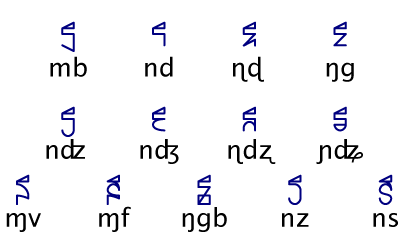
A third type combines a click manner with a click release, omitting the velar bottom of the manner. Here are the clicks from the previous page, this time as ligatures:
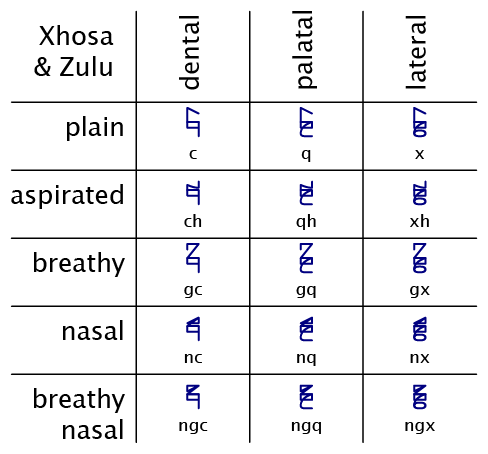
A fourth type combines an alveolar lateral fricative, affricate, or flap with a lateral approximant at a different position, to create a lateral fricative, affricate, or flap at that position. For example, we write a voiced velar lateral affricate by writing a voiced alveolar lateral affricate followed by a voiced velar lateral approximant. The first has a Pu (arch) bottom; the second has a Pu top, so the two are combined by merging the two circles. Because of that, we use a voiced approximant (with an unvoiced fricative or affricate) even if the sound is unvoiced.

A fifth type is used to spell non-sibilant homorganic affricates. In this case, the ligature combines a plosive closure with a fricative release. But since the two letters share the same bottom - they're homorganic! - we don't need to repeat it: we write the plosive top, then the fricative top, then the shared bottom. For example, the German affricate pf would be typed as (with a labiodental p), but a ligature font would display it as . There are also some rhotic affricates that have this type of ligature.
Here's a selection of affricate ligatures. I'll let you try to figure out how they're pronounced before looking at the table below.
| | | | | | | | |
| | | | | | | | |
| | | | | | | ||
| | | | | | |
And here's a table showing all the ligatures in our ligature fonts: the ligature in blue, the component letters in black, and the IPA in green. On the Font Table page, when you choose a ligature font, these ligatures also appear.
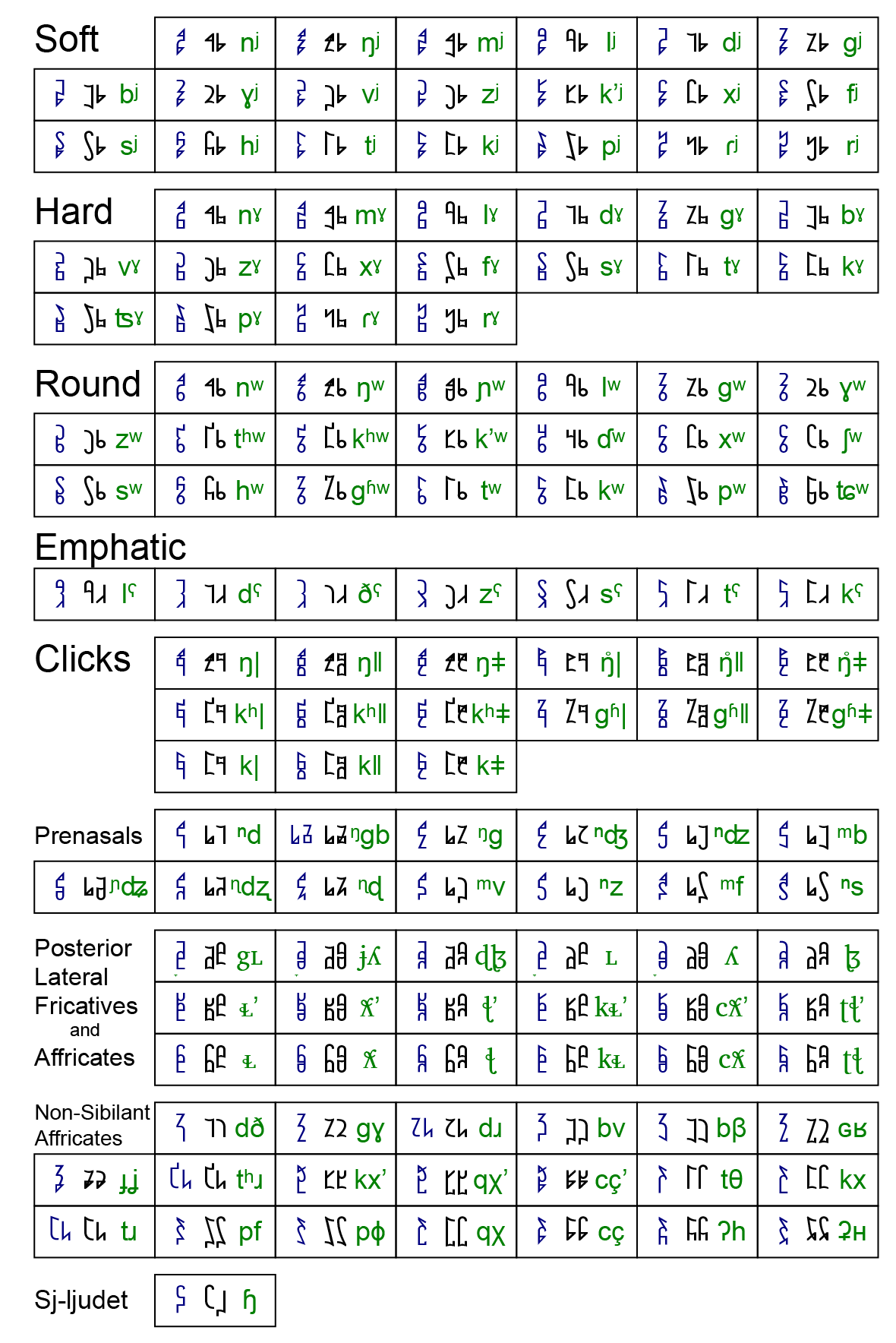
A ligature can be used anywhere you would have written the suffixed equivalent, and if you're using a ligature font, the ligature will appear automatically - you don't have to do anything special. But what if you don't want a ligature, for some reason?
For example, in the Spanish word abierto, the i will be spelled in Musa with a y , since ie is a diphthong - the two sounds are in the same syllable. But in the word abyecto, there is a syllable break between the b and the y, which should be spelled with a Musa Break . This Break will prevent the two from forming a ligature.
There are rare cases when you might not want a ligature, even within a syllable. For example, Yaqui distinguishes between the sequence bw and labialized bʷ, both written in Musa. In the first case, the w is a semivowel; in the second, it's a suffix. To distinguish them, you could use the approximant w for the first case, or you could use a ligature for the labialized suffix, and use a stand-alone w for the semivowel. In this case, you have to use a trick: you have to insert a Zero-Width Non-Joiner (ZWNJ, Unicode 200C) between the consonant and the semivowel, to prevent a ligature. The ZWNJ is available on the Musa keyboard by typing Muni - the key is marked , with two vertical lines that don't join up.
| < More Voices | Accents > |
| © 2002-2025 The Musa Academy | musa@musa.bet | 26mar25 |